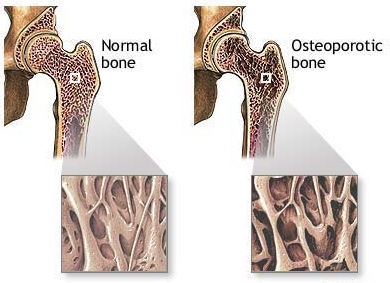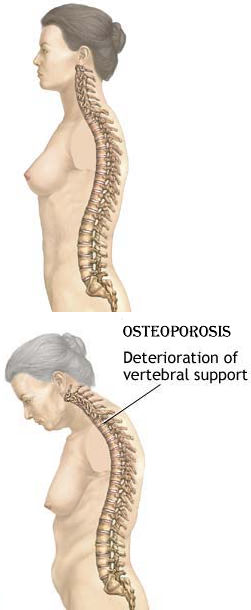Bone
Loss in Pre- and Post-menopausal Women with HIV
 |
 |
 |
 |
 |
 |
 |
| SUMMARY:
Women with HIV are
at risk for bone loss, especially after menopause, according
to 2 recently published studies. Pre-menopausal HIV
positive women had lower bone mineral density than HIV
negative women, but experienced a similar modest rate
of decline over 2.5 years. Post-menopausal HIV positive
women, however, had lower bone mineral density, a higher
rate of osteopenia, and higher levels of biomarkers
of bone turnover, indicating that they could be a greater
risk for fractures. |
|
 |
 |
 |
 |
 |
 |
 |
By
Liz Highleyman
Pre-menopause
In the first study, described in the February
2010 Journal of Acquired Immune Deficiency Syndromes,
Michael Yin from Columbia University Medical Center and colleagues
used dual energy x-ray absorptiometry (DEXA) to compared bone
mineral density (BMD) in younger women with and without HIV.

The
analysis included 100 HIV positive and 68 at-risk HIV negative
pre-menopausal women in the Women's Interagency HIV Study (WIHS).
As a group, HIV positive women were slightly older on average
than the HIV negative women (40 vs 36 years) and more likely to
be coinfected with hepatitis C (31% vs 12%).
About
60% were taking antiretroviral therapy (ART), including 22% on
protease inhibitor-based regimens, 25% on NNRTI-based regimens,
and 6% on nucleoside/nucleotide reverse transcriptase inhibitors
(NRTIs) only. In addition, 15% were treatment-naive and 26% had
used ART in the past but were currently off treatment.
The researchers measured BMD at the lumbar spine (lower back)
and femoral neck (the narrow section of the thigh bone below the
ball joint of the hip) at an initial visit and again at a follow-up
visit after a median 2.5 years.
Results
 |
At
the index visit, HIV positive women had BMD within the normal
range, but approximately 5% lower than HIV negative women
at the lumbar spine and femoral neck. |
 |
Over
the duration of follow-up, HIV positive women experienced
small but significant decreases in BMD at the lumbar spine
and femoral neck (-1.9% at both sites). |
 |
However,
annual percentage decreases in BMD did not differ significantly
between HIV positive and HIV negative women at the lumbar
spine (-0.8% vs -0.4%, respectively) or femoral neck (-0.8%
vs -0.6%). |
 |
Mean
T scores (a standardized measure of bone density) were within
the normal range (> -1.0) in both groups, but significantly
lower among HIV positive women. |
 |
Z
scores (another standardized measure) were also in the normal
range for age (> -2.0) in both groups, with a trend toward
being lower in HIV positive women. |
 |
Changes
remained similar after adjusting for age, body weight, and
BMD at the index visit. |
 |
9%
of HIV positive women showed osteoporosis at the lumbar spine,
but none at the femoral neck; HIV negative women had no osteoporosis
at either site. |
 |
Similar
proportions of HIV positive and HIV negative women experienced
rapid bone loss, defined as more than a 3% decrease in BMD
per year (14% vs 10% at the lumbar spine; 10% vs 6% at the
femoral neck). |
 |
Among
HIV positive women, low BMD was significantly associated with
lower body weight and heavier alcohol use. |
 |
In
a multivariate analysis controlling for other factors, bone
loss was significantly associated with vitamin D deficiency
and opiate/opioid drug use. |
 |
However,
there was no significant association with current CD4 cell
count, CD4 nadir (lowest-ever level), AIDS diagnosis, overall
exposure to ART, class of antiretroviral drugs used, or exposure
to tenofovir (Viread,
also in the Truvada
an Atripla
combination pills). |
 |
Mean
parathyroid hormone (PTH) and vitamin D levels were similar
in HIV positive and HIV negative women; in both groups, however,
vitamin D levels were well below the optimal level for bone
health (32 ng/mL). |
 |
The
incidence of self-reported fractures was 0.74 per 100 person-years
among HIV positive women (3 fractures), similar to the rate
of 1.03 per 100 person-years (2 fractures) among HIV negative
women. |
 "In
pre-menopausal HIV positive women, index BMD was lower than comparable
HIV negative women," the study authors summarized. "[H]owever,
rates of bone loss at the lumbar spine and femoral neck were similar
over 2.5 years of observation, irrespective of antiretroviral
therapy." "In
pre-menopausal HIV positive women, index BMD was lower than comparable
HIV negative women," the study authors summarized. "[H]owever,
rates of bone loss at the lumbar spine and femoral neck were similar
over 2.5 years of observation, irrespective of antiretroviral
therapy."
"Our data suggest that in contrast to advanced untreated
HIV infection or initiation of ART, cytokine levels and bone turnover
markers are not elevated in ART-experienced pre-menopausal women,
and rates of bone loss are modest in such women," they elaborated
in their discussion.
The researchers noted that limitations of the study include lack
of hormone level measurements, body composition analysis, or nutritional
assessment. In addition, the small sample size of the longitudinal
analysis did not permit inferences about the effects of specific
antiretroviral drugs on BMD.
"Our results provide some reassurance that short-term bone
loss is modest in the majority of pre-menopausal, weight stable
HIV positive women," they concluded. "However, a cumulative
annual 1% decrease in young women, given the expected acceleration
during the menopausal transition, may predispose these women to
premature fragility fractures as they age."
Columbia University Medical Center, New York, NY; Data Solutions
LLC, Bronx, NY; University of California at San Francisco and
San Francisco Veterans Affairs Medical Center, San Francisco,
CA; Stroger (formerly Cook County) Hospital and Rush University,
Chicago, IL; New York Medical College, Valhalla, NY; Johns Hopkins
Bloomberg School of Public Health, Baltimore, MD; Montefiore Medical
Center, Bronx, NY.
Post-menopause
In the second study, reported in the December 4, 2009 advance
online edition of the Journal of Clinical Endocrinology &
Metabolism (Abstract),
Yin and a different team of colleagues looked at bone mineral
density and bone turnover among older, post-menopausal women with
HIV.
This prospective cohort study included 92 HIV positive and 95
HIV negative post-menopausal Hispanic and African-American women.
The investigators assessed BMD by DEXA, fracture prevalence, serum
levels of inflammatory cytokines (tumor necrosis factor alpha
[TNF-alpha], interleukin 6 [IL-6]), bone turnover markers (N-telopeptide
and C-telopeptide), calciotropic (calcium affecting) hormones,
and estrone.
As a group, the HIV positive women were significantly younger
(56 vs 60 years) and had lower body mass index (28 vs 30). About
80% of the HIV positive women were on ART, including 39% taking
protease inhibitor-based regimens and 28% taking NNRTI-based regimens.
Results
 |
HIV
positive women had 4.5% lower BMD at the lumbar spine compared
with HIV negative women. |
 |
HIV
positive women were significantly more likely than HIV negative
women to have T scores < -1.0 at the lumbar spine (78%
vs 64%), total hip (45% vs 29%), and femoral neck (64% vs
46%). |
 |
Z
scores adjusted for BMI were lower among HIV positive women
at all 3 sites. |
 |
Serum
TNF-alpha, N-telopeptide, and C-telopeptide levels were significantly
higher in HIV positive women, particularly those receiving
ART, compared with HIV negative women. |
 |
HIV
status was independently and negatively associated with lumbar
spine and total hip BMD after adjusting for age, race/ethnicity,
body mass index, and alcohol use. |
 |
Again,
BMD was not significantly associated with CD4 count, HIV viral
load, AIDS diagnosis, duration of ART, or class of antiretroviral
drugs. |
 |
HIV
positive and HIV negative women had similar frequency of fractures
at the spine, hip, and forearm; however, HIV positive women
reported significantly more fractures at other sites including
ribs, ankles, shoulders, and pelvis. |
"The
lower BMD, higher prevalence of low BMD, and higher levels of
bone turnover markers detected in HIV positive post-menopausal
minority women could place them at high risk for future fractures,"
they study authors concluded.
The researchers suggested that differences in BMD might be due
to the fact that HIV positive women have higher bone turnover
and higher levels of inflammatory cytokines.
"Importantly, low body weight is a powerful risk factor for
osteoporotic fracture," they elaborated in their discussion.
"Thus, the fact that BMD is lower in HIV positive individuals
is of clinical relevance, whether or not the mechanism by which
it is lower is attributable directly to HIV or mediated indirectly
by effects of HIV on weight or other parameters."
Columbia University Medical Center, New York, NY; Bronx-Lebanon
Hospital Center, Bronx, NY; Weill Cornell Medical College, New
York, NY.
2/2/10
References
MT
Yin, D Lu, S Cremers, and others. Short-Term Bone Loss in HIV-Infected
Premenopausal Women. Journal of Acquired Immune Deficiency
Syndromes
53(2): 202-208 (Abstract).
February 2010.
MT Yin, DJ McMahon, DC Ferris, and others. Low Bone Mass and High
Bone Turnover in Postmenopausal Human Immunodeficiency Virus-Infected
Women. Journal of Clinical Endocrinology & Metabolism
(Abstract).
December 4, 2009 (Epub ahead of print).
|
|
|
